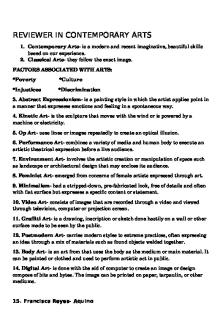Assignment 4: Visual Arts in Education PDF

| Title | Assignment 4: Visual Arts in Education |
|---|---|
| Author | Divya Varde |
| Course | Ways of Knowing |
| Institution | University of Maryland Baltimore County |
| Pages | 1 |
| File Size | 47.7 KB |
| File Type | |
| Total Downloads | 33 |
| Total Views | 184 |
Summary
Professor McAlpine
...
Description
Divya Varde Professor McAlpine INDS 330 28 September 2016 Assignment 4 Michelle Seu does a very well job in explaining the approaches of both Nick Sousanis in his book “Unflattening” and Scott McCloud’s work in “Understanding Comics: The Invisible Art.” Both authors had a similar aspect seen throughout their works—the use of visual art to incorporate into educational approaches throughout disciplines. Sousanis effectively uses both art and words to stress on the issue of “flatness” in education in the United States and how to combat the negative stigma associated with interdisciplinary education (Seu, 2016). In Seu’s analysis of “Unflattening,” she identifies two ways in which Sousanis’ work is interdisciplinary: reasoning through analogies and the other being, building complex, multicasual explanations. Sousanis does an excellent job in using reasoning through analogies to advocate for his stance on the issue of “flatness.” According to Miller and Boix Mansilla, reasoning through analogies refers to “mapping the properties and relations from one domain onto those of another domain” (2004). In chapter one, Sousanis nails the point of an established systematic educational program that individuals are guided to go through. By illustrating individuals standing on an assembly line, Sousanis explains how individuals “pass through an elaborate sequence of discrete steps…every procedure is designed to ensure that proper results are achieved” (Sousanis 9). With this bold image, the author begins to paint a picture of how industrialized education is becoming and the underlying issues that are associated with it. Moreover, through each chapter, the reader begins to see the correlation from new issues to the “assembly line” image of individuals. Another instance where Sousanis uses reasoning through analogies is when speaking on how the search for specific disciplines came about. With many new technological and educational advancements taking place in ancient times, the search for “bigger and better” aspects arose. By representing images of a telescope and searchlights, Sousanis states that “this narrowing of focus led to fragmentation— a cascade of individual searchlights” (Sousanis 35). Throughout each chapter, I was able to see Sousanis using the bridging strategy of reasoning through analogies as the primary approach in making his point. The author, as mentioned above, was able to relate one domain to several other domains within each chapter. Perhaps the most significant point made by Sousanis was that “while image is, text is always about” (Sousanis 58). Subtly, Sousanis here advocates for the collaborative use of art and texts in expanding horizons within education in America. Works Cited Boix-Mansilla, Matthew, and Miller, Veronica. “Thinking Across Perspectives and Disciplines.” (2004): 17. Print Souanis, N. (2015). Unflattening. Chapter 3 “The Shape of Our Thoughts.” Seu, M. (2016). Viewing Graphic Content: An Analysis of the Comic as a Scholarly Medium. Interdisciplinary Studies at UMBC: INDS 490H Capstone Project....
Similar Free PDFs

AIE TASK 4 - Arts in education
- 15 Pages

Visual and Performing Arts
- 8 Pages

Visual Arts Assessment Task
- 3 Pages

Visual Arts lesson plan
- 3 Pages

Visual Arts Essay
- 5 Pages

HSC Visual Arts Unseen Notes
- 4 Pages

Contemporary Arts in Visayas
- 21 Pages

REVIEWER IN CONTEMPORARY ARTS
- 5 Pages
Popular Institutions
- Tinajero National High School - Annex
- Politeknik Caltex Riau
- Yokohama City University
- SGT University
- University of Al-Qadisiyah
- Divine Word College of Vigan
- Techniek College Rotterdam
- Universidade de Santiago
- Universiti Teknologi MARA Cawangan Johor Kampus Pasir Gudang
- Poltekkes Kemenkes Yogyakarta
- Baguio City National High School
- Colegio san marcos
- preparatoria uno
- Centro de Bachillerato Tecnológico Industrial y de Servicios No. 107
- Dalian Maritime University
- Quang Trung Secondary School
- Colegio Tecnológico en Informática
- Corporación Regional de Educación Superior
- Grupo CEDVA
- Dar Al Uloom University
- Centro de Estudios Preuniversitarios de la Universidad Nacional de Ingeniería
- 上智大学
- Aakash International School, Nuna Majara
- San Felipe Neri Catholic School
- Kang Chiao International School - New Taipei City
- Misamis Occidental National High School
- Institución Educativa Escuela Normal Juan Ladrilleros
- Kolehiyo ng Pantukan
- Batanes State College
- Instituto Continental
- Sekolah Menengah Kejuruan Kesehatan Kaltara (Tarakan)
- Colegio de La Inmaculada Concepcion - Cebu







